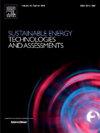A novel pipeline VIV-based synergetic hybrid renewable energy harvesting system for sustainable underwater WSN and IoT applications
IF 7.1
2区 工程技术
Q1 ENERGY & FUELS
Sustainable Energy Technologies and Assessments
Pub Date : 2024-11-02
DOI:10.1016/j.seta.2024.104056
引用次数: 0
Abstract
Flow-induced motion of underwater pipelines could beneficially serve as an excellent host for energy extraction in the modern information-based offshore and deep ocean environments that are reluctant towards the conventional means of external power supply. In this paper, a novel dual-functional hybrid tandem electromagnetic-piezoelectric (EM/PVDF) energy harvesting and VIV mitigation configuration is suggested and computationally implemented that is particularly suitable for powering large scale underwater wireless sensor networks (UWSNs), subsea installations, and Internet of Underwater Things (IoUTs). Furthermore, the key characteristics of major state-of-the-art energy harvesting technologies for powering UWSNs in the deep ocean monitoring applications are succinctly reviewed, while the basic practical design, implementation, and deployment issues and challenges of similarly adopted EM- and PVDF-based energy harvesting devices in the realistic ocean environment are briefly scrutinized. The proposed hybrid EM/PVDF hydrokinetic energy harvesting device is comprised of a linearly sprung EM-based near-bottom horizontal circular cylinder (as a representative of seabed pipeline) that is set in tandem arrangement within the close hydrodynamic interaction range near a downstream wall-mounted cantilever bimorph piezo-plate (PVDF) energy harvester. Detailed numerical simulations reveal the significantly enhanced synergetic energy extraction capability of the hybrid assembly by virtue of the flow field coupling effects between the two energy harvesting mechanisms over a relatively broad range of turbulent Reynolds numbers In particular, the time-averaged harvested power at the peak VIV-lockin Reynolds number of the hybrid system is upgraded about 66 % in comparison to the virtual sum of the single-alone EM- and PVDF-based harvesters progressively increasing to about 92 % at the highest Reynolds number considered Also, the EM-based (PVDF-based) energy component of the hybrid EM/PVDF harvester promptly decays (progressively increases) in the second desynchronization region () owing to the consecutive high frequency interactions of a highly asymmetric and intensive 2S-type vortex street emanating from the upstream cylinder.

基于管道 VIV 的新型协同混合可再生能源采集系统,用于可持续的水下 WSN 和 IoT 应用
在现代信息化的近海和深海环境中,水下管道的流动诱导运动可作为能源提取的最佳载体,而传统的外部供电方式却让人望而却步。本文提出并通过计算实现了一种新型双功能混合串联电磁压电(EM/PVDF)能量采集和 VIV 缓解配置,该配置特别适用于为大型水下无线传感器网络(UWSN)、水下设施和水下物联网(IoUT)供电。此外,还简要回顾了在深海监测应用中为 UWSN 供电的主要先进能量采集技术的主要特点,同时简要分析了在现实海洋环境中采用的基于 EM 和 PVDF 的类似能量采集设备的基本实际设计、实施和部署问题与挑战。所提出的 EM/PVDF 混合型水动力能量收集装置由一个基于线性弹簧的 EM 近底水平圆筒(作为海底管道的代表)组成,该圆筒在靠近下游壁装悬臂双晶压电板(PVDF)能量收集器的近距离水动力相互作用范围内串联布置。详细的数值模拟显示,在 5×103≤Re≤3×104 的较宽湍流雷诺数范围内,两种能量收集机制之间的流场耦合效应显著增强了混合组件的协同能量提取能力。特别是,混合系统(PEM/PVDFavg∗)在峰值 VIV 锁定雷诺数(Re=104)下的时间平均捕获功率与基于电磁和 PVDF 的单一捕获器 PEMavg∗+PPVDFavg∗ 的虚拟总和相比提高了约 66%,在最高雷诺数 Re=3×104 时逐步提高到约 92%。此外,在第二个非同步区(Re≥1.5×104),由于来自上游圆筒的高度不对称和密集的 2S 型涡街的连续高频相互作用,EM/PVDF 混合收割机基于 EM 的(基于 PVDF 的)能量分量迅速衰减(逐渐增加)。
本文章由计算机程序翻译,如有差异,请以英文原文为准。
求助全文
约1分钟内获得全文
求助全文
来源期刊

Sustainable Energy Technologies and Assessments
Energy-Renewable Energy, Sustainability and the Environment
CiteScore
12.70
自引率
12.50%
发文量
1091
期刊介绍:
Encouraging a transition to a sustainable energy future is imperative for our world. Technologies that enable this shift in various sectors like transportation, heating, and power systems are of utmost importance. Sustainable Energy Technologies and Assessments welcomes papers focusing on a range of aspects and levels of technological advancements in energy generation and utilization. The aim is to reduce the negative environmental impact associated with energy production and consumption, spanning from laboratory experiments to real-world applications in the commercial sector.
 求助内容:
求助内容: 应助结果提醒方式:
应助结果提醒方式:


